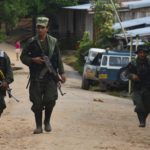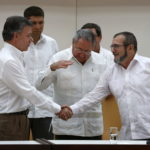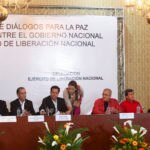Hope for peace remains alive in Colombia
After enduring over 40 civil wars during the 19th century, the 20th century brought the rise of the guerilla warfare to Colombia. Today, in the midst of the 21st century, the country still does not know what it means to live in peace. But hope remains alive today more than ever, thanks to the strides made in the negotiation process that Juan Manuel Santos’ government is holding with the two only guerrillas that remain active in the country, and in Latin America at large: The FARC or Revolutionary Armed Forces of Colombia and the ELN or National Freedom Army. Signing a final deal with these two groups would mean the end of one of the world’s longest-running conflicts in the world.

The rise of the guerrillas in the country came after the partisan violence in the 1950s and as a result of a climate of social injustice and political persecution and exclusion, which built up after the both leading parties of the era, the Liberal and the Conservative, agreed to put their differences aside and rotate in power every four years, during the so-called National Front period (1958 – 1974). Internationally, the triumph of the Cuban revolution fuelled the spirits of those revolting against the status quo, and a deep rift started dividing the Communist Party into a pro-Soviet and a pro-Chinese block.
Three guerrillas in three years
The FARC were born in 1964, after an operation by the Colombian army in the community of Marquetalia, in the El Tolima department, where Pedro Antonio Marín, aka Manuel Marulanda Vélez, and later nicknamed 'Tirofijo (Shureshot)', led a group of Peasant Self-Defence group (or Autodefensas Campesinas) which fought under the “land to the tiller” slogan. In 1966, this faction went from being a defense organization to a self-proclaimed revolutionary force with aspirations to take over power and a clearly pro-soviet ideology.
The ELN was born in 1965 with armed incursions in the Santander department, under the leadership of the Vásquez Castaño brothers, which belonged to the Liberal Revolutionary Movement (MRL) and by a group of university students, some of them trained in Cuba in the art of the guerrilla warfare, which explains their pro-Cuban bias. Unlike the FARC, they denied the need for the Communist party to lead the revolution. A year later, in 1966, the Popular Liberation Army (EPL) was born, inspired by the pro-Beijing communist party, which, following the precepts of Mao Tze Dong, defended that revolution had to start on the countryside to then propagate to the cities, before overthrowing the Government through armed struggle.
But these were not the only subversive groups. Years later, the conflict expanded with the inception of the April 19 Movement (M-19) an urban guerrilla group, in response to the rigging of the 1970 presidential elections. Its members demobilized in 1990, after negotiating with the government the creation of the Constituent Assembly of Colombia, which drafted the 1991 Constitution, currently in force. This event also led to the demobilization that same year of the EPL, the Quintín Lame Indigenous Movement (which took to arms in 1974), the Worker’s Revolutionary Party or PRT - founded in 1982 - and the Socialist Renewal Current group (CRS), which signed a peace treaty in 1994. The Free Homeland Current leftist movement, created in 1983, merged six years later with the ELN.

Armed FARC fighters on a trek across one of the Colombian municipalities without State presence. - Europa Press
Over 40 years of talks
Although the first attempts to negotiate a peace treaty with the different guerrilla groups date back to 1974, negotiations with the two longest-standing ones – FARC and ELN - have always failed. Contrary to how they were handled in El Salvador and Guatemala, involving all armed factions at once, Colombia has addressed its peace talks on an individual basis, spread over time. This approach has added a further level of intricacy to the process.
Colombia’s geographical complexity, in combination with a number of factors, has contributed to keep the conflict alive over time. A few years ago, the United Nations dubbed the Colombian conflict “a classic war in which there would be no winners.”
Colombia’s geographical complexity, in combination with a number of factors, has contributed to keep the conflict alive over time
Eduardo Pizarro Leóngomez, head of the Armed Factions, Conflict and Humanitarian International Law group (Iepri) and member of the National Commission for Reparation of Victims of Actions Repair by Illegal Groups, points at the different reasons that have caused talks to fail in the past: high level of fragmentation within the guerrilla with greatly differing political views, the abandonment of the political track for an exclusively-armed struggle and the militarization of politics and the fact that, in the past, guerrillas have used negotiations to build up their forces.
The processes with the FARC
The first of the two last attempts to negotiate with the FARC took place during Andrés Pastrana’s term of office. During the talks, a demilitarized zone was established in the San Vicente del Caguán municipality, in the Colombian department of El Caquetá. Despite lasting from 1998 to 2002, the process ultimately failed. For the second, launched in 2012, Juan Manuel Santos’s government set out to negotiate a deal in Havana, Cuba.
Pizarro Leóngomez has singled out the differences between these two processes and the factors that increase the likelihood that the current one will succeed. In first instance, the el Caguán process was held within national territory, following an open agenda and with multiple sides, with high involvement of the international community. The Havana process, on the other hand, is benefitting from the fact that it is being negotiated in foreign soil, following a defined agenda, and only between the government and the guerrilla, with limited international participation.A March 23rd deadline was set for the signing of the agreement, but it has not been met. However, on this occasion, all sides seem to be truly committed to reach an agreement, and there is a great degree of optimism regarding the final signing of the peace treaty with the guerrilla.
On the other hand, the first process was negotiated amid a bilateral cease fire within a demilitarized zone, seeking to promote wide-ranging structural transformations. The latter is being negotiated without a bilateral cease-fire, but with the keeping a clear objective: ending the conflict. Finally, in el Caguán, the Armed Forces were not invited to take part in the negotiation, the demobilization was conditioned and the process was undertaken without defining a calendar, while, today, the Armed Forces are playing an active role in the Havana process, the demobilization is the result of an agreement, and a series of deadlines has been set for the process.

President of Colombia, Juan Manuel Santos and head of FARC group Timoleón Jiménez - nicknamed Timochenko - announce from Cuba the signing on the transitional justice agreement before president Raúl Castro. - EFE
What’s missing from the current process?
After three-and-a-half years negotiating with the FARC, the process has entered its final stage. The agenda establishes five general points regarding which a final agreement has been virtually concluded: integral agrarian development, political participation and solution to illicit drug problem, integral system of truth, justice, reparations and non-repetition, and implementation, verification and endorsement.
After three-and-a-half years negotiating with the FARC, the process has entered its final stage
The specific issues that are yet to be agreed upon have to do with the use of the zones that will be created for the concentration of demobilized guerrilla forces. As Semana magazine explained, the purpose of these zones, according to the Government, should be to provide a space where former fighters can transition towards legality, while the FARC want to use them to move from war to politics.
Another issue on which the sides disagree is the possibility of leaving the concentration areas. According to the government, to move beyond these areas, FARC spokespeople should be both authorized and monitored, but the FARC consider that that turns them into captives. The final obstacle is the surrendering of arms. The government expects guerrilla fighters to put their weapons in containers subject to international surveillance as they move into the zone. Only a few weapons would be allowed for settlement surveillance purposes within the area. The FARC argue that the disarmament process has to be progressive.
Although the March 23rd deadline was not met, peace negotiators from all sides remain highly optimistic about the final announcement taking place this year.

Representatives from Colombian Government and the ELN meet in Caracas, Venezuela, to start peace conversations. - EFE
The process with the ELN
The process with the ELN has been a bit more complex. During the exploratory stage, Juan Manuel Santos’ administration took two years to sign the basis for the negotiation on March 30th. In the case of the FARC they were signed within six months. The difficulty with the ELN lies in the group's deep internal rifts.
The negotiation agenda consists of six points: participation of society, democracy for peace, victims, transformations for peace, security for peace and end of the armed conflict and guarantees for the exercise of the political action.
As explained by El Tiempo newspaper, the negotiation with the ELN should not take as long as the process with FARC, because half of the agenda has already been included in the negotiations with the latter - specifically the issues on victims and the end of the conflict. The problem lies in the points of the agenda that are based on citizen participation, which is the main source of discrepancy with the FARC’s agenda.
The talks with the ELN are set to begin next May in Ecuador, while Venezuela, Chile, Brazil and Cuba, the countries that, along with Norway, act as guarantors of the process, have hosted series of exploratory sessions.
The armed conflict has lasted for decades and has taken its toll on the country. However, Colombia has stood out as one of the more stable economies in Latin America, and if the peace treaty is finally signed, its growth and development potential will increase even further.